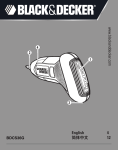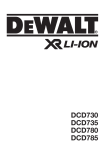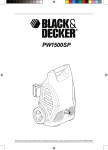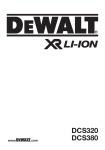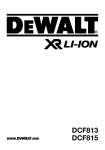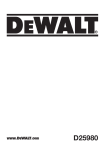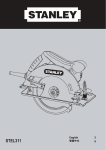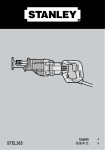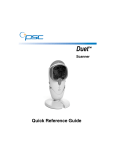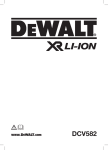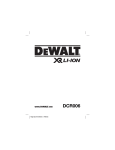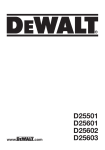Download DeWalt DCD980-XE Technical data
Transcript
DCD980 DCD985 English (original instructions) 3 15 24 Copyright DE WALT 2 Figure 1 e d h f g c b j m a l j i i k Figure 2 i j 1 Figure 3 Figure 4 Figure 5 e e f f g g Figure 7 Figure 6 Figure 8 d Figure 9 h n 2 E NG L I S H 1/2" (13 mm) CORDLESS DRILL/DRIVER DCD980 1/2" (13 mm) CORDLESS HAMMERDRILL/DRIVER DCD985 Congratulations! You have chosen a DeWALT tool. Years of experience, thorough product development and innovation make DeWALT one of the most reliable partners for professional power tool users. Technical Data Voltage Type Battery Type Power output No-load speed 1st gear 2nd gear 3rd gear Impact rate 1st gear 2nd gear 3rd gear Max. torque Chuck capacity Maximum drilling capacity Wood Metal Masonry Weight (without battery pack) W DCD980 18 1 Li-Ion 500 DCD985 18 1 Li-Ion 500 min-1 min-1 min-1 0–575 0–1350 0–2000 0–575 0–1350 0–2000 min-1 min-1 min-1 Nm mm – – – 55 13 0–9775 0–22900 0–34000 55 13 mm mm mm kg 50 13 – 1.77 50 13 16 1.77 VDC An estimation of the level of exposure to vibration should also take into account the times when the tool is switched off or when it is running but not actually doing the job. This may significantly reduce the exposure level over the total working period. Identify additional safety measures to protect the operator from the effects of vibration such as: maintain the tool and the accessories, keep the hands warm, organisation of work patterns. 3 E N GLI SH Battery pack Battery type Voltage Capacity Weight VDC Ah kg DCB180 Li-Ion 18 3.0 0.64 Charger Mains voltage Battery type Approx. charging time min Weight kg DCB181 Li-Ion 18 1.5 0.35 VAC 30 (1.5Ah battery packs) 70 (4.0Ah battery packs) Definitions: Safety Guidelines The definitions below describe the level of severity word. Please read the manual and for each signal pay attention to these symbols. DANGER: Indicates an imminently hazardous situation which, if not avoided, will result in death or serious injury. WARNING: Indicates a potentially hazardous situation which, if not avoided, could result in death or serious injury. CAUTION: Indicates a potentially hazardous situation which, if not avoided, may result in minor or moderate injury. NOTICE: Indicates a practice not related to personal injury which, if not avoided, may result in property damage. Denotes risk of electric shock. Denotes risk of fire. WARNING: To reduce the risk of injury, read the instruction manual. General Power Tool Safety Warnings WARNING! Read all safety warnings and all instructions. Failure to follow the warnings and instructions may result in electric shock, fire and/or serious injury. SAVE ALL WARNINGS AND INSTRUCTIONS FOR FUTURE REFERENCE 4 DCB182 Li-Ion 18 4.0 0.61 DCB183 Li-Ion 18 2.0 0.40 DCB105 220~240 V Li-Ion 40 (2.0Ah battery packs) 90 (5.0Ah battery packs) DCB184 Li-Ion 18 5.0 0.63 55 (3.0Ah battery packs) 0.49 The term “power tool” in the warnings refers to your mains-operated (corded) power tool or batteryoperated (cordless) power tool. 1) WORK AREA SAFETY a) Keep work area clean and well lit. Cluttered or dark areas invite accidents. b) Do not operate power tools in explosive atmospheres, such as in the presence of flammable liquids, gases or dust. Power tools create sparks which may ignite the dust or fumes. c) Keep children and bystanders away while operating a power tool. Distractions can cause you to lose control. 2) ELECTRICAL SAFETY a) Power tool plugs must match the outlet. Never modify the plug in any way. Do not use any adapter plugs with earthed (grounded) power tools. Unmodified plugs and matching outlets will reduce risk of electric shock. b) Avoid body contact with earthed or grounded surfaces such as pipes, radiators, ranges and refrigerators. There is an increased risk of electric shock if your body is earthed or grounded. c) Do not expose power tools to rain or wet conditions. Water entering a power tool will increase the risk of electric shock. d) Do not abuse the cord. Never use the cord for carrying, pulling or unplugging the power tool. Keep cord away from heat, oil, sharp edges or moving parts. Damaged or entangled cords increase the risk of electric shock. E NG L I S H e) When operating a power tool outdoors, use an extension cord suitable for outdoor use. Use of a cord suitable for outdoor use reduces the risk of electric shock. f) If operating a power tool in a damp location is unavoidable, use a residual current device (RCD) protected supply. Use of an RCD reduces the risk of electric shock. 3) PERSONAL SAFETY a) Stay alert, watch what you are doing and use common sense when operating a power tool. Do not use a power tool while you are tired or under the influence of drugs, alcohol or medication. A moment of inattention while operating power tools may result in serious personal injury. b) Use personal protective equipment. Always wear eye protection. Protective equipment such as dust mask, non-skid safety shoes, hard hat, or hearing protection used for appropriate conditions will reduce personal injuries. c) Prevent unintentional starting. Ensure the switch is in the off position before connecting to power source and/or battery pack, picking up or carrying the tool. Carrying power tools with your finger on the switch or energising power tools that have the switch on invites accidents. d) Remove any adjusting key or wrench before turning the power tool on. A wrench or a key left attached to a rotating part of the power tool may result in personal injury. e) Do not overreach. Keep proper footing and balance at all times. This enables better control of the power tool in unexpected situations. f) Dress properly. Do not wear loose clothing or jewellery. Keep your hair, clothing and gloves away from moving parts. Loose clothes, jewellery or long hair can be caught in moving parts. g) If devices are provided for the connection of dust extraction and collection facilities, ensure these are connected and properly used. Use of dust collection can reduce dust-related hazards. 4) POWER TOOL USE AND CARE a) Do not force the power tool. Use the correct power tool for your application. The correct power tool will do the job better and safer at the rate for which it was designed. b) Do not use the power tool if the switch does not turn it on and off. Any power tool that cannot be controlled with the switch is dangerous and must be repaired. c) Disconnect the plug from the power source and/or the battery pack from the power tool before making any adjustments, changing accessories, or storing power tools. Such preventive safety measures reduce the risk of starting the power tool accidentally. d) Store idle power tools out of the reach of children and do not allow persons unfamiliar with the power tool or these instructions to operate the power tool. Power tools are dangerous in the hands of untrained users. e) Maintain power tools. Check for misalignment or binding of moving parts, breakage of parts and any other condition that may affect the power tool’s operation. If damaged, have the power tool repaired before use. Many accidents are caused by poorly maintained power tools. f) Keep cutting tools sharp and clean. Properly maintained cutting tools with sharp cutting edges are less likely to bind and are easier to control. g) Use the power tool, accessories and tool bits etc., in accordance with these instructions taking into account the working conditions and the work to be performed. Use of the power tool for operations different from those intended could result in a hazardous situation. 5) BATTERY TOOL USE AND CARE a) Recharge only with the charger specified by the manufacturer. A charger that is suitable for one type of battery pack may create a risk of fire when used with another battery pack. b) Use power tools only with specifically designated battery packs. Use of any other battery packs may create a risk of injury and fire. c) When battery pack is not in use, keep it away from other metal objects like paper clips, coins, keys, nails, screws or other small metal objects that can make a connection from one terminal to another. Shorting the battery terminals together may cause burns or a fire. d) Under abusive conditions, liquid may be ejected from the battery, avoid contact. If contact accidentally occurs, flush with water. If liquid contacts eyes, additionally 5 E N GLI SH seek medical help. Liquid ejected from the battery may cause irritation or burns. – Risk of squeezing fingers when changing accessories. 6) SERVICE a) Have your power tool serviced by a qualified repair person using only identical replacement parts. This will ensure that the safety of the power tool is maintained. – Health hazards caused by breathing dust developed when working in wood. Additional Specific Safety Rules for Drills/Drivers/Hammerdrills Markings on Tool – Risk of personal injury due to flying particles. – Risk of personal injury due to prolonged use. The following pictograms are shown on the tool: • Wear ear protectors when impact drilling. Exposure to noise can cause hearing loss. • Use auxiliary handles, if supplied with the tool. Loss of control can cause personal injury. Read instruction manual before use. DATE CODE POSITION • Hold power tool by insulated gripping surfaces when performing an operation where the cutting tool may contact hidden wiring. Cutting accessory contacting a “live” wire may make exposed metal parts of the power tool “live” and could give the operator an electric shock. The Date Code, which also includes the year of manufacture, is printed into the housing surface that forms the mounting joint between tool and battery. • Use clamps or other practical way to secure and support the workpiece to a stable platform. Holding the work by hand or against your body is unstable and may lead to loss of control. Important Safety Instructions for All Battery Chargers • Wear ear protectors when hammering for extended periods of time. Prolonged exposure to high intensity noise can cause hearing loss. Temporary hearing loss or serious ear drum damage may result from high sound levels generated by hammerdrilling. • Wear safety goggles or other eye protection. Hammering and drilling operations cause chips to fly. Flying particles can cause permanent eye damage. Example: Year of Manufacture SAVE THESE INSTRUCTIONS: This manual contains important safety and operating instructions for the DCB105 battery charger. • Before using the charger, read all instructions and cautionary markings on charger, battery pack and product using the battery pack. WARNING: Shock hazard. Do not allow any liquid to get inside charger. Electric shock may result. CAUTION: Burn hazard. To reduce the risk of injury, charge only DeWALT rechargeable battery packs. Other types of batteries may overheat and burst resulting in personal injury and property damage. CAUTION: Children should be supervised to ensure that they do not play with the appliance. • Hammer bits and tools get hot during operation. Wear gloves when touching them. Residual Risks The following risks are inherent to the use of percussion drills: – Injuries caused by touching the rotating parts or hot parts of the tool. In spite of the application of the relevant safety regulations and the implementation of safety devices, certain residual risks cannot be avoided. These are: – Impairment of hearing. 6 2011 XX XX NOTICE: Under certain conditions, with the charger plugged in to the power supply, the exposed charging contacts inside the charger can be shorted by foreign material. Foreign materials of a conductive nature such as, but not limited to, steel wool, aluminum foil or any buildup of metallic particles should be kept away from charger cavities. Always unplug the charger from the E NG L I S H power supply when there is no battery pack in the cavity. Unplug charger before attempting to clean. • DO NOT attempt to charge the battery pack with any chargers other than the ones in this manual. The charger and battery pack are specifically designed to work together. • These chargers are not intended for any uses other than charging DeWALT rechargeable batteries. Any other uses may result in risk of fire, electric shock or electrocution. • Do not expose charger to rain or snow. • NEVER attempt to connect 2 chargers together. • The charger is designed to operate on standard 220~240 V household electrical power. Do not attempt to use it on any other voltage. This does not apply to the vehicular charger. SAVE THESE INSTRUCTIONS Chargers The DCB105 charger accepts 10.8 V, 14.4 V and 18V Li-lon (DCB125, DCB127, DCB140, DCB141, DCB180, DCB181, DCB182, DCB183, DCB184 and DCB185) battery packs. • Pull by plug rather than cord when disconnecting charger. This will reduce risk of damage to electric plug and cord. This charger requires no adjustment and is designed to be as easy as possible to operate. • Make sure that cord is located so that it will not be stepped on, tripped over or otherwise subjected to damage or stress. Charging Procedure (Figure 2) • Do not use an extension cord unless it is absolutely necessary. Use of improper extension cord could result in risk of fire, electric shock or electrocution. • When operating a charger outdoors, always provide a dry location and use an extension cord suitable for outdoor use. Use of a cord suitable for outdoor use reduces the risk of electric shock. • Do not block the ventilation slots on the charger. The ventilation slots are located on the top and sides of the charger. Place the charger in a position away from any heat source. • Do not operate charger with damaged cord or plug — have them replaced immediately. • Do not operate charger if it has received a sharp blow, been dropped or otherwise damaged in any way. Take it to an authorised service centre. • Do not disassemble the charger; take it to an authorised service centre when service or repair is required. Incorrect reassembly may result in a risk of electric shock, electrocution or fire. • In case of damaged power supply cord the supply cord must be replaced immediately by the manufacturer, its service agent or similar qualified person to prevent any hazard. • Disconnect the charger from the outlet before attempting any cleaning. This will reduce the risk of electric shock. Removing the battery pack will not reduce this risk. 1.Plug the charger into an appropriate 220~240 V outlet before inserting the battery pack. 2.Insert the battery pack (i) into the charger, making sure the pack is fully seated in the charger. The red (charging) light will blink continuously indicating that the charging process has started. 3.The completion of charge will be indicated by the red light remaining ON continuously. The pack is fully charged and may be used at this time or left in the charger. NOTE: To ensure maximum performance and life of Li-Ion batteries, charge the battery pack fully before first use. Charging Process Refer to the table below for the state of charge of the battery pack. State of charge charging –– –––– –– fully charged ––––––––––––––––– hot/cold pack delay –– • –– • –– • –– • x problem pack or charger • • • • • • • • • • • • problem powerline •• •• •• •• •• •• This charger will not charge a faulty battery pack. The charger will indicate faulty battery by refusing to light or by displaying problem pack or charger blink pattern. NOTE: This could also mean a problem with a charger. 7 E N GLI SH If the charger indicates a problem, take the charger and battery pack to be tested at an authorised service centre. fully charged before use. WARNING: Never attempt to open the battery pack for any reason. If the battery pack case is cracked or damaged, do not insert it into the charger. Do not crush, drop or damage battery pack. Do not use a battery pack or charger that has received a sharp blow, been dropped, run over or damaged in any way (e.g., pierced with a nail, hit with a hammer, stepped on). Electric shock or electrocution may result. Damaged battery packs should be returned to the service centre for recycling. CAUTION: When not in use, place tool on its side on a stable surface where it will not cause a tripping or falling hazard. Some tools with large battery packs will stand upright on the battery pack but may be easily knocked over. Hot/Cold Pack Delay When the charger detects a battery that is too hot or too cold, it automatically starts a hot/cold pack delay, suspending charging until the battery has reached an appropriate temperature. The charger then automatically switches to the pack charging mode. This feature ensures maximum battery life. XR Li-Ion tools are designed with an Electronic Protection System that will protect the battery against overloading, overheating or deep discharge. The tool will automatically turn off if the Electronic Protection System engages. If this occurs, place the Li-Ion battery on the charger until it is fully charged. A cold battery pack will charge at about half the rate of a warm battery pack. The battery pack will charge at that slower rate throughout the entire charging cycle and will not return to maximum charge rate even if the battery warms. Important Safety Instructions for All Battery Packs When ordering replacement battery packs, be sure to include the catalog number and voltage. The battery pack is not fully charged out of the carton. Before using the battery pack and charger, read the safety instructions below and then follow the charging procedures outlined. READ ALL INSTRUCTIONS • Do not charge or use the battery pack in explosive atmospheres, such as in the presence of flammable liquids, gases or dust. Inserting or removing the battery pack from the charger may ignite the dust or fumes. • Never force the battery pack into charger. Do not modify the battery pack in any way to fit into a non-compatible charger as battery pack may rupture causing serious personal injury. • Charge the battery packs only in designated DeWALT chargers. • DO NOT splash or immerse in water or other liquids. • Do not store or use the tool and battery pack in locations where the temperature may reach or exceed 40˚ C (105° F) (such as outside sheds or metal buildings in summer). • For best results, make sure the battery pack is 8 SPECIFIC SAFETY INSTRUCTIONS FOR LITHIUM ION (Li-Ion) • Do not incinerate the battery pack even if it is severely damaged or is completely worn out. The battery pack can explode in a fire. Toxic fumes and materials are created when lithium ion battery packs are burned. • If battery contents come into contact with the skin, immediately wash the area with mild soap and water. If the battery liquid gets into the eye, rinse water over the open eye for 15 minutes or until irritation ceases. If medical attention is needed, the battery electrolyte is composed of a mixture of liquid organic carbonates and lithium salts. • Contents of opened battery cells may cause respiratory irritation. Provide fresh air. If symptoms persists, seek medical attention. WARNING: Burn hazard. Battery liquid may be flammable if exposed to spark or flame. Battery Pack BATTERY TYPE The DCD980 and DCD985 operate on 18 volt battery pack. The DCB180, DCB181, DCB182, DCB183 or DCB184 battery packs may be used. Refer to Technical Data for more information. E NG L I S H Storage Recommendations Do not incinerate the battery pack. 1.The best storage place is one that is cool and dry away from direct sunlight and excess heat or cold. For optimum battery performance and life, store battery packs at room temperature when not in use. Charges Li-Ion battery packs. See Technical Data for charging time. 2.For long storage, it is recommended to store a fully charged battery pack in a cool, dry place out of the charger for optimal results. NOTE: Battery packs should not be stored completely depleted of charge. The battery pack will need to be recharged before use. Labels on Charger and Battery Pack In addition to the pictographs used in this manual, the labels on the charger and the battery pack show the following pictographs: Only for indoor use. Package Contents The package contains: 1 cordless percussion drill (DCD985) 1 cordless midhandle drill driver (DCD980) 1 Li-Ion battery pack (L1, M1, P1 models) Read instruction manual before use. 2 Li-Ion battery packs (L2, M2, P2 models) 3 Li-Ion battery packs (L3, M3, P3 models) Charging. Fully charged. Hot/cold pack delay. x Problem pack or charger. Problem powerline. 1 Kitbox 1 Charger 1 Side handle 1 Instruction manual NOTE: Battery packs, chargers and kitboxes are not included with N-models. • Check for damage to the tool, parts or accessories which may have occurred during transport. Do not probe with conductive objects. • Take the time to thoroughly read and understand this manual prior to operation. Do not charge damaged battery packs. Description (Figure 1, 2) Use only with DeWALT battery packs. Others may burst, causing personal injury and damage. a.Trigger switch Do not expose to water. Have defective cords replaced immediately. Charge only between 4° C and 40° C. Discard the battery pack with due care for the environment. WARNING: Never modify the power tool or any part of it. Damage or personal injury could result. b.Forward/reverse control button c.Worklight d.Chuck e.Torque adjustment collar f. Mode control collar g.Gear shifter h.Side handle i.Battery pack 9 E N GLI SH j. Battery release button k.Belt hook ASSEMBLY AND ADJUSTMENTS WARNING: Prior to assembly and adjustment, always remove the battery pack. Always switch off the tool before inserting or removing the battery pack. WARNING: Use only DeWALT battery packs and chargers. l.Mounting screw m.Bit clip INTENDED USE These drills drivers/hammerdrills are designed for professional drilling, percussion drilling and screwdriving applications. DO NOT use under wet conditions or in presence of flammable liquids or gases. These drills/drivers/hammerdrills are professional power tools. Inserting and Removing the Battery Pack from the Tool (Figure 2) NOTE: For best results, make sure your battery pack is fully charged. TO INSTALL THE BATTERY PACK INTO THE TOOL HANDLE DO NOT let children come into contact with the tool. Supervision is required when inexperienced operators use this tool. 1.Align the battery pack (i) with the rails inside the tool’s handle (Figure 2). • This product is not intended for use by persons (including children) suffering from diminished physical, sensory or mental abilities; lack of experience, knowledge or skills unless they are supervised by a person responsible for their safety. Children should never be left alone with this product. TO REMOVE THE BATTERY PACK FROM THE TOOL Electrical Safety The electric motor has been designed for one voltage only. Always check that the battery pack voltage corresponds to the voltage on the rating plate. Also make sure that the voltage of your charger corresponds to that of your mains. Your DeWALT charger is double insulated in accordance with EN 60335; therefore no earth wire is required. If the supply cord is damaged, it must be replaced by a specially prepared cord available through the DeWALT service organization. WARNING: No connection is to be made to the earth terminal. Follow the fitting instructions supplied with good quality plugs. Recommended fuse: 3 A. Using an Extension Cable An extension cord should not be used unless absolutely necessary. Use an approved extension cable suitable for the power input of your charger (see Technical Data). The minimum conductor size is 1 mm2; the maximum length is 30 m. When using a cable reel, always unwind the cable completely. 10 2.Slide it into the handle until the battery pack is firmly seated in the tool and ensure that it does not disengage. 1.Press the battery release button (j) and firmly pull the battery pack out of the tool handle. 2.Insert battery pack into the charger as described in the charger section of this manual. Variable Speed Switch (Figure 1) To turn the tool on, squeeze the trigger switch (a). To turn the tool off, release the trigger switch. Your tool is equipped with a brake. The chuck will stop as soon as the trigger switch is fully released. NOTE: Continuous use in variable speed range is not recommended. It may damage the switch and should be avoided. Side Handle (Figure 1) WARNING:To reduce the risk of personal injury, ALWAYS operate the tool with the side handle properly installed. Failure to do so may result in the side handle slipping during tool operation and subsequent loss of control. Hold tool with both hands to maximize control. The side handle (h) clamps to the front of the gear case and may be rotated 360˚ to permit right- or left-hand use. Side handle must be tightened sufficiently to resist the twisting action of the tool if the accessory binds or stalls. Be sure to grip the side handle at the far end to control the tool during a stall. E NG L I S H If model is not equipped with side handle, grip drill with one hand on the handle and one hand on the battery pack. NOTE: Side handle comes equipped on all models. Forward/Reverse Control Button (Figure 1) A forward/reverse control button (b) determines the direction of the tool and also serves as a lock off button. To select forward rotation, release the trigger switch and depress the forward/reverse control button on the right side of the tool. To select reverse, release the trigger switch and depress the forward/reverse control button on the left side of the tool. NOTE: The torque adjustment collar may be set to any number at any time. However, the torque adjustment collar is only engaged during screwdriving mode and not in drill and hammerdrill modes. HAMMERDRILLING (Figure 5) CAUTION: the drill/hammerdrill mode, the drill will not clutch out regardless of the position of the torque adjustment collar (e). Rotate the mode control collar (f) so the hammer symbol is aligned with the arrow. Torque Adjustment Collar (Figure 3–5) NOTE: The first time the tool is run after changing the direction of rotation, you may hear a click on start up. This is normal and does not indicate a problem. Your tool has an adjustable torque screwdriver mechanism for driving and removing a wide array of fastener shapes and sizes. Circling the torque adjustment collar (e) are numbers. These numbers are used to set the clutch to deliver a torque range. The higher the number on the collar, the higher the torque and the larger the fastener which can be driven. To select any of the numbers, rotate until the desired number aligns with the arrow. Worklight (Figure 1) Three-Speed Gearing (Figure 3–5) The center position of the control button locks the tool in the off position. When changing the position of the control button, be sure the trigger is released. There is a worklight (c) located just above the trigger switch (a). The worklight will be activated when the trigger switch is squeezed. When the trigger is released the worklight will stay illuminated for up to 20 seconds. NOTE: The worklight is for lighting the immediate work surface and is not intended to be used as a flashlight. Mode Control Collar (Figure 3–5) Your drill is equipped with a separate mode control collar (f) to switch between drilling, screwdriving and hammerdrilling mode. DRILLING (FIGURE 3) CAUTION: When the mode collar is in the drill/hammerdrill mode, the drill will not clutch out regardless of the position of the torque adjustment collar (e). The three-speed feature of your tool allows you to shift gears for greater versatility. To select speed 1 (highest torque setting), turn the tool off and permit it to stop. Slide the gear shifter (g) all the way forward. Speed 2 (middle torque and speed setting) is in the middle position. Speed 3 (highest speed setting) is to the rear. NOTE: Do not change gears when the tool is running. Always allow the drill to come to a complete stop before changing gears. If you have trouble changing gears, make sure that the gear shifter is engaged in one of the three speed settings. Chucks WARNING: Do not attempt to tighten drill bits (or any other accessory) by gripping the front part of the chuck and turning the tool on. Damage to the chuck and personal injury may result. Always lock off trigger switch and disconnect tool from power source when changing accessories. WARNING: Always ensure the bit is secure before starting the tool. A loose bit may eject from tool causing possible personal injury. Rotate the mode control collar (f) so the drill symbol is aligned with the arrow. NOTE: The torque adjustment collar (e) may be set on any number. SCREWDRIVING (FIGURE 4) Rotate the mode control collar (f) so the screw symbol is aligned with the arrow. 11 E N GLI SH KEYLESS SINGLE SLEEVE CHUCK (FIGURE 6–8) Your tool features a keyless chuck with one rotating sleeve for one-handed operation of the chuck. To insert a drill bit or other accessory, follow these steps. 1.Lock the trigger in the OFF position. Turn off tool and disconnect tool from power source. 2.Grasp the black sleeve of the chuck (d) with one hand and use the other hand to secure the tool as shown in Figure 6. Rotate the sleeve counterclockwise (as viewed from the front) far enough to accept the desired accessory. 3.Insert the accessory about 19 mm (3/4") into the chuck (Figure 7). Tighten securely by rotating the chuck sleeve clockwise with one hand while holding the tool with the other hand (Figure 8). Continue to rotate the chuck sleeve until several ratchet clicks are heard to ensure full gripping power. OPERATION Instructions for Use WARNING: Always observe the safety instructions and applicable regulations. WARNING: To reduce the risk of serious personal injury, turn tool off and disconnect tool from power source before making any adjustments or removing/installing attachments or accessories. Proper Hand Position (Figure 9) WARNING: To reduce the risk of serious personal injury, ALWAYS use proper hand position as shown in Figure 9. WARNING: To reduce the risk of serious personal injury, ALWAYS hold securely in anticipation of a sudden reaction. To release the accessory, repeat Steps 1 and 2 above. Be sure to tighten chuck with one hand on the chuck sleeve and one hand holding the tool for maximum tightness. Proper hand position requires one hand on the main handle (n), with the other hand on the side handle (h). Belt Hook and Bit Clip (Figure 1) Drill Operation (Figure 3) WARNING: To reduce the risk of serious personal injury, turn tool off and disconnect battery pack before making any adjustments or removing/installing attachments or accessories. WARNING: To reduce the risk of serious personal injury, turn tool off and disconnect tool from power source before making any adjustments or removing/installing attachments or accessories. WARNING: To reduce the risk of serious personal injury, DO NOT suspend tool overhead or suspend objects from the belt hook. ONLY hang tool’s belt hook from a work belt. WARNING: To reduce the risk of serious personal injury, ensure the screw holding the belt hook is secure. WARNING: To reduce the risk of personal injury, ALWAYS ensure workpiece is anchored or clamped firmly. If drilling thin material, use a wood “back-up” block to prevent damage to the material. IMPORTANT: When attaching or replacing the belt hook or bit clip, use only the screw (l) that is provided. Be sure to securely tighten the screw. The belt hook (k) and bit clip (m) can be be attached to either side of the tool using only the screw (l) provided, to accommodate left- or right- handed users. If the hook or bit clip is not desired at all, it can be removed from the tool. To move belt hook or bit clip, remove the screw (l) that holds it in place then reassemble on the opposite side. Be sure to securely tighten the screw. 12 1.Select the desired speed/torque range using the gear shifter to match the speed and torque to the planned operation. Set the mode control collar to the drill symbol. 2.For WOOD, use twist bits, spade bits, power auger bits or hole saws. For METAL, use highspeed steel twist drill bits or hole saws. Use a cutting lubricant when drilling metals. The exceptions are cast iron and brass which should be drilled dry. 3.Always apply pressure in a straight line with the bit. Use enough pressure to keep the drill bit biting, but do not push hard enough to stall the motor or deflect the bit. E NG L I S H the hole with the tool still running to help clear debris from the hole. 4.Hold tool firmly with both hands to control the twisting action of the drill. 5.IF DRILL STALLS, it is usually because it is being overloaded. RELEASE TRIGGER IMMEDIATELY, remove drill bit from work, and determine cause of stalling. DO NOT CLICK TRIGGER OFF AND ON IN AN ATTEMPT TO START A STALLED DRILL – THIS CAN DAMAGE THE DRILL. 6.Keep the motor running when pulling the bit back out of a drilled hole. This will help prevent jamming. 5.For masonry, use carbide-tipped bits or masonry bits. A smooth, even flow of dust indicates the proper drilling rate. MAINTENANCE Your DeWALT power tool has been designed to operate over a long period of time with a minimum of maintenance. Continuous satisfactory operation depends upon proper tool care and regular cleaning. Screwdriver Operation (Figure 4) 1.Select the desired speed/torque range using the three-speed gear shifter (g) on the top of tool to match the speed and torque to the planned application. Initially set the torque adjustment collar (e) at a lower setting to ensure the fastener to be set to your specification. NOTE: Use the lowest torque setting required to seat the fastener at the desired depth. The lower the number, the lower the torque output. WARNING: To reduce the risk of serious personal injury, turn tool off and disconnect battery pack before making any adjustments or removing/installing attachments or accessories. An accidental start-up can cause injury. The charger and battery pack are not serviceable. There are no serviceable parts inside. 2.Rotate the mode control collar (f) so the screw symbol is aligned with the arrow. Lubrication 3.Reset the torque adjustment collar (e) to the appropriate number setting for the torque desired. Make a few practice runs in scrap or unseen areas to determine the proper position of the torque adjustment collar. Cleaning NOTE: The torque adjustment collar may be set to any number at any time. However, the torque adjustment collar is only engaged during screwdriving mode and not in drill and hammerdrill modes. Hammerdrill Operation (Figure 5) 1.Select the desired speed/torque range using the gear shifter to match the speed and torque to the planned operation. Set the mode control collar (f) to the hammer symbol. Your power tool requires no additional lubrication. WARNING: Blow dirt and dust out of the main housing with dry air as often as dirt is seen collecting in and around the air vents. Wear approved eye protection and approved dust mask when performing this procedure. WARNING: Never use solvents or other harsh chemicals for cleaning the non-metallic parts of the tool. These chemicals may weaken the materials used in these parts. Use a cloth dampened only with water and mild soap. Never let any liquid get inside the tool; never immerse any part of the tool into a liquid. 2.When drilling, use just enough force on the hammer to keep it from bouncing excessively. Too much force will cause slower drilling speeds, overheating, and a lower drilling rate. 3.Drill straight, keeping the bit at a right angle to the work. Do not exert side pressure on the bit when drilling as this will cause clogging of the bit flutes and a slower drilling speed. 4.When drilling deep holes, if the hammer speed starts to drop off, pull the bit partially out of CHARGER CLEANING INSTRUCTIONS WARNING: Shock hazard. Disconnect the charger from the AC outlet before cleaning. Dirt and grease may be removed from the exterior of the charger using a cloth or soft non-metallic brush. Do not use water or any cleaning solutions. 13 E N GLI SH Optional Accessories WARNING: Since accessories, other than those offered by DeWALT, have not been tested with this product, use of such accessories with this tool could be hazardous. To reduce the risk of injury, only DeWALT recommended accessories should be used with this product. Consult your dealer for further information on the appropriate accessories. Protecting the Environment Separate collection. This product must not be disposed of with normal household waste. Should you find one day that your DeWALT product needs replacement, or if it is of no further use to you, do not dispose of it with household waste. Make this product available for separate collection. S eparate collection of used products and packaging allows materials to be recycled and used again. Re-use of recycled materials helps prevent environmental pollution and reduces the demand for raw materials. Local regulations may provide for separate collection of electrical products from the household, at municipal waste sites or by the retailer when you purchase a new product. DeWALT provides a facility for the collection and recycling of DeWALT products once they have reached the end of their working life. To take advantage of this service please return your product to any authorised repair agent who will collect them on our behalf. You can check the location of your nearest authorised repair agent by contacting your local DeWALT office at the address indicated in this manual. Alternatively, a list of authorised DeWALT repair agents and full details of our after-sales service and contacts are available on the Internet at: www.2helpU.com. Rechargeable Battery Pack This long life battery pack must be recharged when it fails to produce sufficient power on jobs which 14 were easily done before. At the end of its technical life, discard it with due care for our environment: • Run the battery pack down completely, then remove it from the tool. • Li-Ion cells are recyclable. Take them to your dealer or a local recycling station. The collected battery packs will be recycled or disposed of properly. 简 体 中文 锂电池充电式高负载冲击钻 DCD980,DCD985 祝贺您! 感谢您选择得伟工具。凭借多年的经验以及全面的产品开发与创新,得伟已经成为专业电动工具使用者最值 得信赖的伙伴之一。 如果你对这款或者任何的得伟工具有任何的疑问或者意见,请致电:800-820-4221或者 400-620-4221 技术数据 DCD980 DCD985 电压 18 18 类型 1 1 电池类型 锂离子 锂离子 空载转速 1档 2档 3档 0-575 0-1350 0-2000 0-575 0-1350 0-2000 冲击速率 1档 2档 3档 - 0-9775 0-22950 0-34000 最大扭矩 45 45 夹头尺寸 13 13 最大钻孔能力 木材 钢材 砖石结构 50 13 - 50 13 16 1.77 1.77 重量 电池组 电池类型 电压 容量 重量 VDC 安时 千克 DCB180 DCB181 DCB182 DCB183 DCB184 锂电 18 3.0 0.64 锂电 18 1.5 0.35 锂电 18 4.0 0.61 锂电 18 2.0 0.40 锂电 18 5.0 0.63 充电器 电源电压 电池类型 大约充电时间 分钟 重量 千克 V DC 30 (1.5安时电池组) 70 (4.0安时电池组) DCB105 220 锂电 40 (2.0安时电池组) 90 (5.0安时电池组) 55 (3.0安时电池组) 0.49 15 简 体中文 定义:安全准则 3) 人身安全 下列定义解释了各警示词的严重程度。请仔细阅读本 手册并注意这些符号。 危险: 指示紧急的危险情形,如不加以避免, 将导致死亡或严重伤害。 a) 保持警觉,当操作电动工具时关注所从事的操作 并保持清醒。切勿在有疲倦、药物、酒精或治疗反应 下操作电动工具。在操作电动工具期间精力分散会导 致严重人身伤害。 警告:指示潜在的危险情形,如不加以避免, 可能导致死亡或严重伤害。 b) 使用安全装置。始终配戴护目镜。安全装置,诸如 适当条件下的防尘面具、防滑安全鞋、安全帽、听力 防护等装置能减少人身伤害。 警示:指示潜在的危险情形,如不加以避免, 可能导致轻度或中度伤害。 c) 避免突然起动。确保开关在插入插头时处于关断 位置。手指放在已接通电源的开关上或开关处于接 通时插入头可能会导致危险。 注意:指示不涉及人身伤害的情况,如不加 以避免,可能导致财产损失。 表示有触电风险。 d) 在电动工具接通之前,拿掉所有调节钥匙或扳 手。遗留在电动工具旋转零件上的扳手或钥匙会导致 人身伤害。 表示存在火灾风险。 警告:为降低伤害风险,请阅读使用手册。 电动工具安全通则 请妥善保管所有警示与须知,以备将来参考使用 警告!请仔细阅读所有安全警告和指示说明。 不遵循下列的警告和指示则可能会导致触电、 火灾和/或严重伤害。 在所有以下列举的警告中术语“电动工具”指用电驱 动(有线)电动工具或电池驱动(无线)电动工具。 1、工作场所安全 a) 保持工作场地清洁和明亮。混乱和黑暗的场地会 引发事故。 b) 不要在易爆环境,如有易燃液体、气体或粉尘的 环境下操作电动工具。电动工具产生的火花会点燃粉 尘或气体。 c) 让儿童和旁观者离开后操纵电动工具。分心会使 你放松控制。 2、电气安全 e) 手不要伸得太长。时刻注意脚下和身体平衡。这 样在意外情况下能很好地控制电动工具。 f) 着装适当。不要穿宽松衣服或佩带饰品。让你的 头发、衣服和袖子远离运动部件。宽松衣服、佩饰或 长发可能会卷入运动部件。 g) 如果提供了与排屑装置、集尘设备连接用的装 置,则确保他们连接完好且使用得当。使用这些装置 可减少碎屑引起的危险。 4)电动工具使用和注意事项 a) 不要滥用电动工具,根据用途使用适当的电动工 具。选用适当的设计额值的电动工具会使你工作有 效、更安全。 b) 如果开关不能接通或关断工具电源,则不能使用 该电动工具。不能用开关来控制的电动工具是危险的 且必须进行修理。 c) 在进行任何调节、更换附件或贮存电动工具之 前,必须从电源上拔掉插头和/或将电池盒脱开电 源。这种防护性措施将减少电动工具突然起动的危 险。 d) 将闲置电动工具贮存在儿童所及范围之外,并且 不要让不熟悉电动工具或对这些说明不了解的人操 作电动工具。电动工具在未经训练的用户手中是危险 的。 a) 电动工具插头必须与插座相配。不能以任何方式 改装插头。需接地的电动工具不能使用任何转换插 头。未经改装的插头和相配的插座将减少触电危险。 e) 保养电动工具。检查运动部件的安装偏差或卡 住、零件破损情况和影响电动工具运行的其它条件。 如有损坏,电动工具必须在使用前修理好。许多事故 由维护不良的电动工具引发。 b) 避免人体接触接地表面,如管道、散热片和冰箱。 如果你身体接地会增加触电危险。 f) 保持切削刀具锋利和清洁。保养良好的有锋利切 削刃的刀具不易卡住而且容易控制。 c) 不得将电动工具暴露在雨中或潮湿环境中。水进 入电动工具将增加触电危险。d) 不得滥用电线。绝 不能用电线搬运、拉动电动工具或拔出其插头。让电 动工具远离热、油、锐边或运动部件。受损或缠绕的 电线会增加触电危险。 g) 按照使用说明书以及打算使用的电动工具的特殊 类型要求的方式,考虑作业条件和进行的作业来使 用电动工具、附件和工具的刀头等。电动工具用作那 些与要求不符的操作可能会导致危险情况。 e) 当在户外使用电动工具时,使用适合户外使用的 外接电线。适合户外使用的电线将减少触电危险。 f) 如果在潮湿的环境中使用电动工具,请使用漏电 保护装置(RCD)。使用此装置可降低触电危险。 16 简体中文 5、电池式工具使用和注意事项 工具上的标识 a) 只用制造商规定的充电器充电。将适用于某种电 池盒的充电器用到其他电池盒时会发生着火危险。 本工具上附带下列图形: b) 只使用配有特制电池盒的电动工具。使用其他电 池盒会发生损坏和着火危险。 c) 当电池盒不用时,将它远离其他金属物体,例如回 形针、硬币、钥匙、钉子、螺钉或其他小金属物体,以 防一端与另一端连接。电池端部短路会引起燃烧或者 火灾。 使用前阅读使用手册。 日期码的位置 日期码包含制造年份,已经印在工具外壳上,位置介 于工具和电池之间的接合处。 d) 在滥用条件下,液体会从电池中溅出;避免接触。 如果无意间碰到了,用水冲洗。如果液体碰到了眼 睛,还要寻求医疗帮助。从电池中溅出的液体会发生 腐蚀或燃烧。 例如: 6、维修 适用于所有电池充电器的重要安全守则 将你的电动工具送交专业维修人员,必须使用同样的 备件进行更换。这样确保所维修的电动工具的安全 性。 请妥善保管好这些说明:本手册含有适用于DCB105电 池充电器的重要安全和操作守则。 冲击钻安全细则 使用充电器之前,请阅读充电器、电池组以及使用电 池组的产品的所有守则和注意标示。 ∙请佩戴听力保护器。暴露在噪音中会损伤听力。 ∙请使用随工具提供的辅助手柄。工具失控会导致人 身伤害。 ∙操作过程中钻头可能接触隐藏的电线时,请握住工 具的绝缘表面。钻头如果接触到“带电”导线,电动 工具金属部件表面就会“带电”并使操作人员触电。 ∙请使用夹钳或其它切实可行的方法来固定和支撑工 件,将其固定到稳定的工作台上。用手抓住工件或用 身体抵住工件并不稳定,可能会导致工件失控。 ∙任何时候都必须紧握工具。切勿试图单手操作工 具。否则会导致工具失控。钻进或碰到硬材料也是危 险的。 ∙请佩戴安全护目镜或其它护目装备。锤击和钻孔作 业时,会产生大量飞散的碎片。飞扬的颗粒会造成眼 睛永久性伤害。 ∙使用过程中,工具和配件会发烫。如果使用时会发 热,例如冲击钻或钻金属时,请佩戴手套。 ∙通风孔下通常有转动部件,请注意预防。宽松的衣 服、首饰或长发容易被卷入运动的部件中。 剩余风险 以下风险是使用冲击钻所固有的: - 接触旋转部件或灼热部件造成的伤害。 尽管实行了相关的安全法规、采用了安全装置,某些 残余风险是不可避免的,它们是: - 听力损伤 - 更换配件时挤伤手指的风险 - 木工作业时,吸入粉尘导致的健康风险 - 迸飞的颗粒导致人身伤害风险。 - 长期使用时导致人身伤害风险。 2011 XX XX 制造年份 警告:触电危险。切勿使任何液体进入充电 器。这可能导致触电。 警示:灼伤危险。要降低受伤的风险,只使用 得伟充电式电池充电。其他类型的电池可能会 爆裂,导致人身伤害和损害。 警示:必须监督儿童,确保他们没有玩耍本工 具。 注意:特定条件下,充电器连接电源后,充电器内暴 露的充电触头会被异物短路。导电性异物,包括但 不限于钢绒、铝箔或聚集的金属颗粒,应远离充电 器腔室。当腔室内没有电池组时,切记拔下充电器 插头。清洁充电器前,亦应拔下其插头。 切勿尝试使用本手册说明以外的任何充电器为电 池组充电。充电器和电池组经特别设计以便配合工 作。 除了为得伟充电式电池充电以外,这些充电器并非 设计用于其他用途。任何其他用途可能导火灾、触电 或电击的风险。 不得将充电器暴露在雨中或雪中。 断开充电器连接时拔下插头,切勿拉拽电线。这将 减低对电插头和电源线的损害风险。 确保电源线布置在不易踩踏、踢绊、拉扯或会受到 损害或压力的位置。 不得使用延长电源线,除非有绝对的必要。使用不 正确的延长电源线可能导致火灾、触电或电击的风 险。 在室外使用充电器时,应选择干燥的地点并使用 适合室外使用的延长线。室外专用的延长线能够降 低触电风险。 17 简 体中文 不得遮盖充电器上的通风槽。通风槽位于充电器的 顶部及侧面。充电器应远离任何热源。 操作充电器时,不得使用损坏的电源线或插头 — 必须立即将其更换。 本充电器不能给已经损坏的电池充电。充电器不亮、 闪烁类型为电池或充电器故障时,均可表示电池损 坏。 注意:这也可能表示充电器故障。 若充电器遭受重击、掉落或因任何方式引起的损 坏,切勿操作该充电器。将它送往授权的检修中心。 充电器显示故障时,请把充电器和电池组送往授权服 务中心检测。 不得拆卸充电器;在需要检修或维修时将它送往 授权的检修中心,错误的重装可能导致触电、电击或 火灾的风险。 热/冷电池组延迟 为避免发生危险,电源线一旦损坏,必须立即联系 厂商、服务代理或类似有资质的人员更换。 尝试进行任何清洁工作之前,请将充电器插头从 插座上断开。这将降低触电的危险。取出电池组并不 会降低此危险。 禁止尝试将两个充电器连接在一起。 充电器设计用于采用220V家用电源操作。不得尝 试使用任何其他电压操作。上述不适用于车用充电 器。 充电器 D C B10 5充电器 接受10.8 V、14.4 V 和18 V 锂离子 (DCB125,DCB127,DCB140,DCB41,DCB180,DCB181, DCB182,DCB183,DCB184 和 DCB185)电池组。 当充电器检测到电池过热或过冷时,它会自动启动热 /冷电池延迟模式,暂停充电,直到电池达到适当的 温度。然后,充电器会自动切换到电池组充电模式。 此功能可确保电池拥有最长的使用寿命。 XR 锂电池工具的设计带有防止电池超载、过热或深 度放电的电子保护系统。 如果电子保护系统处于运作状态,该工具将自动停止 运转。如果发生这种情况,请将锂电池放在充电器上 直到完全充电。 冷电池组充电速率是温热的电池组充电速率的一半 左右。电池组在整个充电周期的充电速度都会较慢, 即使电池升温也不会返回到最高速度。 这些充电器无需任何调整,专为简易操作而设计。 适用于所有电池组的重要安全守则 充电步骤(图2) 在订购替换电池组时,请提供产品目录号和电压。 1.在插入电池组之前,请把充电器插入合适的220伏 特插座中。 2.将电池组(i)插入充电器中,确保电池完全放入充 电器内。红(充电)灯会连续闪烁,表示充电过程已经 开始。 3.红灯保持持续发光时,表示充电已经完成。此时, 充满电的电池可供使用,也可留在充电器中。 注意:为确保锂电池性能和寿命最大化,首次使用前 请将电池充满电。 充电过程 有关电池组的充电状态可参考下表 充电状态 电池充 电中 电池已 充满 从包装箱取出的电池组并非完全充电。使用电池组和 充电器之前,请阅读下列安全守则。然后遵循所述的 充电程序。 请阅读所有守则 禁止在易燃液体、气体或粉尘等存在的易爆环境中 充电或使用电池组。在充电器中插入或取出电池会点 燃粉尘或气体。 勿将电池强行放入充电器。不得以任何方式改动电 池来放入不兼容的充电器,否则电池会破裂并导致严 重的人身伤害。 电池组只可在得伟充电器中充电。 切勿喷溅或沉浸在水中或其他液体中。 勿在温度达到或超过40o C(105o F)(例如夏天 的室外凉棚或金属建筑物)存放或使用电池组。 获得最佳效果,请在使用前确保电池组充满电 警告:禁止以任何理由打开电池组。 高/低温电池 组延迟充电 x 电池或充 电器故障 电源电路 故障 18 如果电池组壳体破裂或损坏,切勿将其放入充电 器中。不得挤压、损坏电池组或使其跌落。如果电 池组或充电器曾被重击、跌落、碾压或发生其它方 式的损坏(例如针刺、锤击、踩踏等),则不得使 用。否则可能导致触电或电死事故。损坏的电池组 应交给维修中心回收。 简体中文 警示:放置不用时,将工具侧放在平稳的 表面上,以避免绊倒或摔落的风险。一些 工具的电池组外形尺寸较大,可以直立在 电池组上,但可能很容易被打翻。 x 电池或充电器故障 电源电路故障 锂 离 子 电 池 组 的 附 加 安 全 守 则(L i — Lon) 切勿插入任何导电物件 不论电池组是严重受损或完全损坏,切勿焚化电 池组。电池组会在火中爆炸。锂离子电池组在燃烧 时会释放有毒烟雾和物质。 不要对损坏的电池组充电 如果皮肤接触到电池内含物质,应立即用中性肥 皂和清水冲洗。如果电池液沾到眼睛,应睁开眼睛 用清水冲洗至少15分钟或直到眼睛不会感到刺激为 止。若需要医疗帮助,电池电解液是由液状有机碳 酸盐和锂盐混合组成的。 电池打开后,其内含物质可能会刺激呼吸系统。 呼吸新鲜空气,如果症状持续,请寻求医疗帮助。 只能使用得伟电池组,使用其他电池组 可能会爆裂,导致人身伤害和损害 不要暴露在水中 警告:灼伤危险。如果暴露在火花或火焰 中,电池液可能会燃烧。 应立即替换故障的电源线 只在介于4o C和40o C的环境中充电 电池组 电池类型 弃置电池组时,请妥善处理以保护我们 的环境。 使用18伏特电池组。 可使用DCB180, DCB181, DCB182, DCB183 或 DCB184型电池组。 存储建议 切勿焚化电池组 1.最佳的储存地点应凉爽干燥,远离直射阳光和热 源或冷源的位置。为了优化电池的效能和使用寿 命,请在不使用时应将电池组存放在室温环境。 锂离子电池组充电 2.长期存放时,为达到最佳效果,建议将冲满电的 电池组从充电器中取出,并存放在凉爽、干燥的地 点。 注意:电池组不可在电量耗尽的情况下存放。电池 组在使用前应再次充电。 充电时间请参阅技术数据 仅限室内使用 包装内容 本包装内含有:无线冲击钻1台 充电器和电池组上的标签 锂电池组1块 (L1, M1, P1 型) 除了本手册中使用的图形符号外,充电器和电池组 上的标签会显示下列图形符号: 锂电池组2块 (L2, M2, P2 型) 使用前阅读使用手册 电池充电中 锂电池组3块 (L3, M3, P3 型) 工具箱1个 充电器1个 侧手柄1 支 说明书1本 电池已充满 高/低温电池组延迟充电 19 简 体中文 说明(图1) a.触发开关 b.正转/反转控制按钮 注意:为达到最佳效果,请确保电池组已充满电。电 池组完全放电后,指示灯会在没有任何预警的情况下 关闭。 c.换档器 将电池组安装到工具手柄中 d.六角腔室 1.把电池组(i)与工具手柄内的轨道对正(图2)。 e.工作灯 2.把电池组滑入手柄,直至牢固固定,确保不会松 脱。 f.皮带钩 g.锚固螺钉 h.钻头卡子 i.电池组 j.电池释放按钮 k.夹头及六角腔室 预期用途 本电钻设计用于专业钻孔和拧螺丝用途。 从工具上取下电池组 1.按下电池释放按钮(j),把电池组用力从工具手柄 中拉出。 2.按照本手册充电器部分的说明,将电池组插入充电 器。 调速开关 (图 1) 要启动工具,按下触发开关(a)即可。 禁止在潮湿或存在易燃液体、气体的条件下使用本工 具。 要关闭工具,释放触发开关即可。本工具配有制动 器。一旦完全释放触发开关,夹头会立即停止。。 本电钻为专业电动工具,禁止儿童接触。缺乏经验的 人须在监护下使用本工具。 注意:不建议持续使用变速。它可能会损坏开关,应 加以避免。 除非其安全负责人进行工具使用的监督或指导,否 则体力、感知能力或心智不足的人(包括儿童),以及 缺乏经验与相关知识的人不得使用本工具。切勿让儿 童独自留在工具旁。 侧手柄(图1) 电气安全 电动马达仅设计为一种电压。请务必检查电池组电压 是否与铭牌一致。请确保您的充电器电压与您的主电 源一致。 如果电源线损坏,必须采用得伟维修机构提供的专用 线。 警告:接地端子无须接线。 警告:为降低严重人身伤害风险,使用工具 时请务必正确安装侧手柄。否则,侧手柄会在 使用过程中滑动、失控。请双手紧握工具,提 高可控性。 侧手柄(h)连接于齿轮箱的前部,可360°旋转,便于 惯用左手或右手的人操作。侧手柄必须充分紧固,以 承受工具卡住或失速时导致的扭转效应。请确保握住 侧手柄的远端,以便在失速时控制工具。 如果您的工具型号没有配备侧手柄,请一只手抓住手 柄,另一只手握住电池组。 注意:所有型号均配有侧手柄。 使用延长电缆 正转/反转控制按钮(图1) 仅在绝对必要时使用延长电缆。使用得延长电缆必 须经过批准并满足您充电器的功率输入(见“技术参 数”)要求。最小导体面积为1平方毫米,最大长度为 30米。 正转/反转控制按钮(b)不仅能够控制工具的旋转方 向,还可作为关闭锁定按钮使用。 使用电缆卷筒时,请确保电缆完全展开。 要选择正转,请释放触发开关,然后按下工具右侧的 正转/反转控制按钮。 安装与调整 警告:安装与调整之前,必须取出电池组。插入 或取出电池组之前,请关闭工具电源。 警告:只能使用得伟电池组和充电器。 电池组在工具上的拆、装步骤(图2) 20 要选择反转,请释放触发开关,然后按下工具左侧的 正转/反转控制按钮。 控制按钮的中心位置能够把工具锁定在关闭位置。 改变控制按钮的位置前,请确保释放触发开关。 简体中文 注意:工具运行时,切勿换档。换档前,务必待工具完 全停止。如果换档有困难,请确保换档器位于最前或 最后位置。 工作灯 (图 1) 靠近触发开关(a)的正上方有一工作灯(c)。挤压触 发开关时,工作灯即被点亮。 释放触发开关后,工作灯会继续亮长达20秒钟。 注意:工作灯用于照明直接的工作表面,并非设计作 为手电筒使用。 模式控制环(图3-5) 本电钻配有独立的模式控制环(f),可以在钻孔、起 子、冲击钻模式间切换。 钻孔(图3) 警告:当模式控制环处于电钻/冲击钻模式时 式时,无论扭矩调节环(e)的位置如何,电钻 离合器均不会启动。 三速档位调节(图3-5) 本工具的三档特性可以任意换档,用途更广泛。要选 择1档(最高扭矩设定),请关闭工具,待其停止。然 后,把换档器(g)向前滑动到底。2档(中度扭矩和速 度设定)在中间位置。3档(最高速度设定)在后部位 置。 注意:工具运行时,切勿换档。换档前,务必待工具完 全停止。如果换档有困难,请确保换档器位于三个速 度设定之一上。 夹头 警告:切勿通过握住夹头前部同时启动工具 来紧固钻头(或其它配件)。否则,会导致夹 头损坏和人身伤害。更换配件时,务必锁定 触发开关,断开工具电源插头。 警告:启动工具前,请确保钻头已拧紧。松开 的钻头会弹出工具,导致人身伤害。 无键单套筒夹头(图6-8) 本工具配有无键夹头。它带一旋转套筒,用于夹头的 单手操作。要插入钻头或其它附件,请按如下步骤操 作。 旋转模式控制环(f),使箭头对准钻头符号。 1.将触发开关锁定在OFF位置。关闭工具并拔下电源 插头。 注意:扭矩调节环(e)可设定到任意数字上。 2.一只手握住夹头(d)的黑色套筒,另一只手固定工 具,如图6所示。逆时针(从前端看)旋转套筒,使其 足以容纳所需配件。 拧螺丝(图4) 旋转模式控制环(f),使箭头对准螺钉符号。 注意:扭矩调节环可在任何场合设定到任意数字上。 但是扭矩调节环仅在拧螺丝模式下启动,在钻孔和冲 击钻模式时不启动。 冲击钻(图5) 警告:当模式控制环处于电钻/冲击钻模式 时,无论扭矩调节环(e)的位置如何,电钻离 合器均不会启动。 旋转模式控制环(f),使箭头对准锤子符号。 扭矩调节环(图3-5) 本工具配有扭矩可调节的起子机系统,可以紧固或拆 卸各种类型和尺寸的紧固件。扭矩调节环(e)的圆周 上有数字,用于设定离合器的扭矩范围。数值越大, 扭矩越大,能够驱动的紧固件也越大。要选择某个数 值,请旋转直至其对准箭头。 3.把配件插入夹头约19毫米(3/4”)(图7),然后一只 手把持工具,另一只手顺时针旋转夹头套筒(图8)。 不停旋转,直至听到几声啮合的卡塔声,以确保足够 的夹持力。 要释放配件,重复上述第1、2步。 请使用一只手握住夹头套筒,一只手握住工具,紧固 到最大限度。 皮带钩和配件卡子(图1) 警告:为降低严重人身伤害的风险,在进行 任何调整或安装/拆卸附件与配件前,请关闭 开关并取下电池组。 警告:为降低严重人身伤害的风险,禁止把 工具悬挂在头部上方,或在皮带钩上悬挂其 它物体。皮带钩仅可悬挂于工作皮带上。 警告:为避免严重人身伤害的风险,请确保 固定皮带钩的螺钉牢固可靠。 重要提示:安装或更换皮带钩、配件卡子时,仅可使 用随工具提供的螺钉(I)。请确保螺钉牢牢紧固。 21 简体中文 仅可使用随工具提供的螺钉(I),把皮带钩(k)和配件 卡子(m)连接到工具的任一侧,无论是惯用右手或左 手的人均可方便使用。如果根本不需要皮带钩,可从 工具上取下。 要移动皮带钩或配件卡子,取下紧固螺钉(I),然后重 新组装到工具另一侧上。请确保拧紧螺钉。 操作步骤 使用说明 警告:请始终遵守安全守则以及适用法规的 要求。 警告:为降低严重人身伤害的风险,在进行 任何调整或安装/拆卸附件与配件前,请关闭 开关并断开电源。 正确手部位置(图 3) 警告:为降低严重人身伤害风险,请始终使 用正确的手部位置,如图所示。 警告:为降低严重人身伤害风险,请始终紧 握工具以防止意外事件。 正确的手部位置要求一只手握住主握柄 (n),另一只 手则握住副手柄 (h)。 注意:按要求的最低扭矩设定把紧固件紧固到要求 深度。数值越低,扭矩输出越小。 2.旋转模式控制环(f),使箭头对准螺钉符号。 3.根据扭矩要求,把扭矩调节环(e)重新设定在所需 位置。在废料或不可见区域尝试几次,确定扭矩调节 环的正确位置。 注意:扭矩调节环可在任何场合设定到任意数字上。 但是扭矩调节环仅在拧螺丝模式下启动,在钻孔和冲 击钻模式时不启动。 冲击钻操作步骤(图5) 1.使用换档器选择所需转速/扭矩,与作业要求的速 度和扭矩相匹配。把模式控制环(f)设定到锤子符 号。 2.钻孔时,施加的力能够防止工具过度反弹即可。用 力过大会降低钻孔转速,导致过热、钻速慢。 3.垂直钻孔,使钻头与工件成直角。钻孔时,切勿对钻 头施加侧向力。否则会导致钻头出屑槽堵塞,降低钻 孔速度。 4.钻深孔时,一旦工具速度开始降低,请保持工具运 转,同时把钻头部分拉出,以帮助排屑。 5.对于砖石砌体,请使用硬合金钻头或混凝土钻头。 如果排屑滑顺,甚至象流动起来一样,就说明钻孔速 度是合适的。 钻孔操作步骤 警告:为降低严重人身伤害的风险,在进行 任何调整或安装/拆卸附件与配件前,请关闭 开关并断开电源。 警告:为了降低人身伤害的风险,请务必确 保工件锚固或夹持牢固。如果在较薄材料上 钻孔,请使用木材“衬垫”来防止材料损坏。 1.使用档位选择器,选择所需速度/扭矩范围,与作业 要求相匹配。将模式控制环设定到钻孔符号。 2.钻木材时,应使用麻花钻头、扁钻头、机械螺旋钻 头或孔锯。钻金属时,使用高速钢麻花钻头或孔锯。 钻金属时,使用切削润滑剂;但铸铁和黄铜出外,必 须干钻。 3.用力方向始终与钻头成一直线。请施加足够大的压 力,保证钻进所需;但不要大到马达失速或钻头倾 斜。 4.请双手紧握电钻,控制电钻的扭转效应。 5.如果电钻失速,常常是由于过载。请立即松开触 发开关,从工件上退出钻头,查找失速的原因。切勿 试图通过不停按下—松开触发开关来启动失速的电 钻——这会损坏电钻。 6.从成孔中拉出钻头时,请保持马达运转。这有助于 防止卡死。 拧螺丝操作步骤(图1) 1.使用工具顶部的三速换档器(g)选择所需转速/扭 矩,与作业要求的速度和扭矩相匹配。开始时,把扭 22 保养 您的得伟电动工具设计精良,可以长期使用,仅需要 极少维护。要连续获得令人满意的工作效果,需要您 进行正确的保养和定期的清洁。 警告:为降低严重的人身伤害风险,在进行任 何调整或取出/安装附加装置或附件之前,请 关闭工具电源和断开电池组连接。意外启动 容易造成人身伤害。 本充电器不可检修。充电器内不含可检修的部件。 润滑 本电动工具无须另行润滑。 清洁 警 告:一旦 通 风口及其周围积聚可见的粉 尘 ,请 即 用 干 燥 的 压 缩 空 气 吹 走 主 机 外 壳内的粉尘和灰尘。进行这一步骤时,请佩戴 经认可的护目装备和认可的面罩。 警告:切勿使用溶剂或其它刺激性化学品来 清洁工具的非金属部件。这些化学品可能削弱 零件中使用的材料。只能使用抹布蘸中性肥 皂水进行清洁。勿使任何液体进入工具;勿使 工具的任何部分浸入液体中。 简体中文 充电器清洁说明 警告:触电危险。清洁之前将充电器从交流电 插座上断开。使用软布或非金属软刷,去除充 电器外部的污垢和油脂。 请勿使用水货任何清洁剂。 附件的选择 警告:由于非得伟附件未经本产品匹配测试, 本工具若使用此类附件,将存在隐患。为降低 人身伤害风险,本产品仅可使用得伟推荐的 附件。 请向零售商咨询合适附近的更多信息。 保护环境 个别收集。本产品必须与一般家庭废物分开处理。 如果您发现您的得伟产品需要进行替换,或您已经 不再需要使用这些产品,请不要将它们与家庭废物一 起处理。务必将本产品送往个别收集处。 个别收集用过的产品和包装允许材料再循环利用。 重新使用循环利用的材料有助于防止环境污染,并减 少原始材料的需求。 当您购买新产品时,可能提供从家用、城市垃圾站或 通过零售商个别收集电气产品的当地法规。 得伟提供设施收集和再循环利用使用寿命到期的得 伟产品。要利用这项服务,请将您的产品送往任何 授权的维修代理,他们将协助我们收集这些回收产 品。 需要查询最靠近您的授权维修代理,您可联络本手 册中所记载的您当地的得伟办事处。您也可以通过网 站获得授权的得伟维修代理列表以及我们售后服务 与联络人的完整详情,网站:www.2helpU.com. 制造商:百得德国公司 地址:Black & Decker Str. 40 65510 Idstein,德 国 产地:墨西哥 23 24 4.0 0.61 40 2.0 0.40 5.0 0.63 55 2.0 Ah 70 4.0 Ah 90 5.0 Ah 25 26 27 DCB125, DCB127, DCB140, DCB141, DCB180, DCB181, DCB182, DCB183, DCB184 x 28 DCB180, DCB181, DCB182, DCB183 DCB184 29 L1, M1, P1 L2, M2, P2 L3, M3, P3 x 30 31 32 33 34 35 N390815 03/2014








































